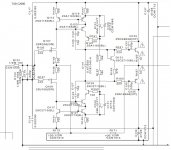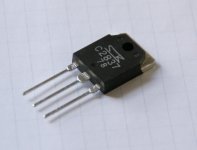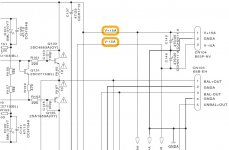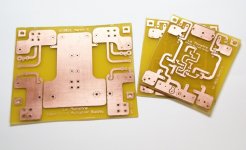... "Hiraga 8 Watt" from Klaus Scherm, Germany.
He changed drivers and output trans, and made a tricky setup with current sources for the input Jfets.
sounds great, and was successful at the poweramp shootout at the german "Frickelfest" ...
Is there a schematic available ?
Hiya,
I decided to build an headphone amp based on the Monstre circuit.
My starting point was the one published by kk-pcb.
Since I wanted much less gain (and lower distortion) I had to touch the feedback resistors. Therefore I chose slow and low-gain driver transistors (the fairchild pair with only 4Mhz Ft) and also added a little compensation on them. I hope this wont make the amp oscillate.
The input jfets are not matched which I have in my scrap bin, likewise for the BC. One heatsink per channel will be used, good up to about 10W.
The two resistors R14 and R15 are just to reduce the power dissipation of the output transistors within the dissipation alu available.
My goal was to keep a nice harmonic spectrum (mostly 2nd and third) and plenty of power/current to drive eventually even orthos, and without using exotic transistors.
I wont start building it before a couple of months, since I have other stuff on schedule, but the simulation looks promising.
PSU will be the regulated sigma22 which I use on most of my headphone amps, with 80-120VA transformer.
You can try this pre/headphone amp, mostly very low 2nd and third harmonic and no global feedback.http://www.diyaudio.com/forums/anal...onveyor-voltage-amplifier-24.html#post3447084
One thing is for certain: I will try this with a capacitance multiplier. The original supply is absurd.
Yes. And add considerable buffer capacitance to the multipliers' regulated outputs.
@Telstar
Hi I haven't read this thread, but came across your post.
The TAD C2000 is a preamp I like, its similar-ish to your post.
It is very interesting, i saved the schematic.
Most of its japanese transistors are unobtainium nowadays I think but it shows well where they needed to compensate.
Do you know how high were the rails?
You can try this pre/headphone amp, mostly very low 2nd and third harmonic and no global feedback.http://www.diyaudio.com/forums/anal...onveyor-voltage-amplifier-24.html#post3447084
I read your thread, it's a good circuit, albeit a bit complicated, and it's not really related to the Hiraga 8W.
I have a long list of preamps/headamps to try, maybe one day i'll build yours too
Fake 2SC2837?
Uh oh, it looks like I probably got a fake 2SC2837 here. It's hard to tell in the photo, but the top looks like it was sanded and relabelled. Doesn't have the right numbers - no O, P, or Y rank. When tested with an Atlas transistor tester, it gave an hFe of 20. Datasheet says 50 should be minimum. I got 4 of them and they all look like this and all test with an hFe ~20.
I got some 2SA1186 from the same supplier and they appear genuine and all test with hFe ~120, which is right in the range specified by the "P" rank that they have marked on them. If they're fake, at least they're more well done than the pathetic 2837s I got...
These came from MCM. I realize ordering from them is a roll of the dice. I've gotten transistors from them before with mixed results.
Uh oh, it looks like I probably got a fake 2SC2837 here. It's hard to tell in the photo, but the top looks like it was sanded and relabelled. Doesn't have the right numbers - no O, P, or Y rank. When tested with an Atlas transistor tester, it gave an hFe of 20. Datasheet says 50 should be minimum. I got 4 of them and they all look like this and all test with an hFe ~20.
I got some 2SA1186 from the same supplier and they appear genuine and all test with hFe ~120, which is right in the range specified by the "P" rank that they have marked on them. If they're fake, at least they're more well done than the pathetic 2837s I got...
These came from MCM. I realize ordering from them is a roll of the dice. I've gotten transistors from them before with mixed results.
Attachments
It is very interesting, i saved the schematic.
Most of its japanese transistors are unobtainium nowadays I think but it shows well where they needed to compensate.
Do you know how high were the rails?
Here is the section showing more
The availability of transistors is sad these days, the amp is 2011 model.
Regards
Attachments
Last edited:
Gigantic amount of capacitance for such a low power amp is absurd, in my opinion. I realize that ripple noise must be at an absolute minimum for good sound with this circuit, but when a more practical circuit can achieve the same ends, I see no value in investing $$$ and space in giant capacitors when they aren't needed. And RC pi circuit is such crude energy-wasting filter... would much rather try this capacitance multiplier.How so?

Ripples in the pond
Hmm, I've just re-read the original articles (OK, an English translation, my French ain't what it used to be!). I had remembered much less capacitance on the battery powered version.
One of the recurring memes with class A designs is that their PSRR is usually pretty poor and much effort is spent cleaning up the PS.
I have a JLH in the house and am planning* two new power supplies: a) a battery based one and b) a choke input supply.
I'm particularly interested in whether the current "super" caps and large car (doof-doof) capacitors can help.
A capacitance multiplier sounds interesting if potentially introducing all sorts of signal related noise. Have fun!
(*Don't anyone hold your breath - it'll take a while before I get anywhere close to doing any work. What fool does post grad studies at my age?)
Gigantic amount of capacitance for such a low power amp is absurd, in my opinion. I realize that ripple noise must be at an absolute minimum for good sound with this circuit,....... would much rather try this capacitance multiplier.
Hmm, I've just re-read the original articles (OK, an English translation, my French ain't what it used to be!). I had remembered much less capacitance on the battery powered version.
One of the recurring memes with class A designs is that their PSRR is usually pretty poor and much effort is spent cleaning up the PS.
I have a JLH in the house and am planning* two new power supplies: a) a battery based one and b) a choke input supply.
I'm particularly interested in whether the current "super" caps and large car (doof-doof) capacitors can help.
A capacitance multiplier sounds interesting if potentially introducing all sorts of signal related noise. Have fun!
(*Don't anyone hold your breath - it'll take a while before I get anywhere close to doing any work. What fool does post grad studies at my age?)
Gigantic amount of capacitance for such a low power amp is absurd, in my opinion. I realize that ripple noise must be at an absolute minimum for good sound with this circuit, but when a more practical circuit can achieve the same ends, I see no value in investing $$$ and space in giant capacitors when they aren't needed. And RC pi circuit is such crude energy-wasting filter... would much rather try this capacitance multiplier.
To my opinion you should ear one Hiraga class A amp one day and I guess you would change your mind. The minimalist topology allows to do what an amp is supposed to do: modulate the voltage at the output in 'real time'.Therefore only ultra high capacitance passive PSU with ultra low ESR can do the job.
A 20W with 0.8A bias class needs 30 Amps! within a few picoseconds when requested. No choice then...
I have got enough original parts to build 5 or 6 amps on the shelf including the NEC 2sd688/2s627 and the TO-3P's for the 30W version. The only issue is the price of good caps! Transformer shoud be a C Core, even a good EI is OK.
The effect of the RC Pi filter on the sound can be discussed. An LC filter is another story. However one of the benefit is the ability to adjust the rail voltages.
Sorry for my approximate English, yes I am French, and also, I met Jean Hiraga a couple of times when I was living in Paris, afficionado of 'La Maison de l'Audiophile' during 15 years. Just my thoughts!
JP
I'm assuming it is for the purpose of compensating for the inductance in the lead wires connecting the boards to the supply.Hi all
what is the purpose of the 2x 470uf caps on each channel of the le monstre ?
Sheafer
Provided that supply noise is filtered to a low enough level, I am certain Le Monstre built with a capacitance multiplier will sound good.
I have built dozens of Le Monstre with capacitance multipliers supplies over the years. It's inevitable, however, to add considerable buffer capacities to their regulated outputs. They have been always much better than passive supplies with or without batteries.
- Home
- Amplifiers
- Solid State
- Hiraga "Le Monstre"



